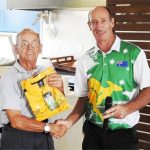Only two months ago we were overwhelmed with the amount of rain we had now we are wondering when the next rain will come as our course is drying out quickly.
Our Thanks to Noosa Land Care:
Noosa Land care acquired funding ($15K) from SEQ Water for a project aiming to help us stabilize the many creek banks that traverse our course. A recent working bee saw the spreading of two types of mulch – hardwood bark higher up the banks and heavier mulch further down the bank. We held another working bee on Tuesday morning 17th September where another 45 cubic m. of mulch was spread on upper banks. The purpose of the mulch is to improve aesthetics from the road and reduce the need to apply herbicide to banks. Picture shows President, Greg Michael on bridge, and in the background, our greens staff working with Land Care people and other volunteers.
The project is now drawing to a close; only costs to the Club were a few hours of green staff time and volunteer time on four occasions. Our sincere thanks go to Noosa Land Care, particularly Ilana Kelly, Project Manager. Ilana and Todd got together last week, to complete paperwork, and on the form was the question – “how can we help you again in the future?” Hopefully we will be working with them again, possibly ensuring the security of our water storage. Stay tuned.
Overhanging Branch Removal
Tony Bernhagen again arranged for his mate Nigel to bring in a “Cherry Picker” to do more work for us on the 1st fairway. This happened on Monday 9th September. Volunteers who helped move branches away from fairways and sawing them into manageable sizes from 4pm, were Tony, Greg Michael, Doug Pearce, Geoff Cowan, Graham Laing and Dave Lyons. Another group next morning continued cutting up debris and moving it to the dump site, included Jim Henderson, Don Clelland, Rex Williams, Ron Blount, Wayne McKinnon, Doug Pearce, Greg Michael and Dave Lyons with assistance from Course Superintendent Todd McNamee.
Condition of our fairways – The Future?
We have a picturesque golf course, intersected with many hazards, lots of trees, water, and 18 challenging holes that defy our low GA course rating. Our greens are always in good condition due to the work done by Todd and his staff. We get very good reports about the greens when we host members from other clubs, in spite of many of them being much older than the generally accepted time for renovation or reconstruction. Our tees are acceptable and will receive topdressing and aeration when possible. As we all know, what holds us back, is our fairways.
Fairway watering has been installed on half of the 1st fairway, part of the 3rd fairway and recently on the 17th fairway before the creek. But have we seen much benefit from that? These areas are a bit greener than the rest during dry spells, but most of the water runs off and little percolates down the soil profile where it is most needed. The purchase of the Toro equipment has resulted in improvements too, particularly the powerful fairway mower which is winning the war with weeds. In addition, the Toro boom spray has allowed us to apply fertilizer to fairways cheaply and efficiently; we don’t have to water the fertilizer in, as needed for solid fertilizer.
Some benefit too has come from using the fairway slicer (Groundhog aerator) which has improved drainage on our fairways by giving some but limited pathway for water to get down the soil profile, instead of puddling on the flatter areas.
But no amount of fairway watering, tree culling, nor fairway fertilizer application will give us the fairways we want unless we address the fundamental issue holding this course back. The solution is to understand the soil we have, and improve it accordingly. Soils on our fairways generally have very low fertility and the clay is of a type that has low water holding capacity and low infiltration rate.
The way to get good landing areas on our fairways with more desirable grass has been clearly demonstrated by the construction of the green couch nursery on the RHS of the 4th fairway. When members next walk from the 3rd green to the 4th tee picture as Todd said two weeks back, “ask yourself wouldn’t you like to be playing golf shots off fairways like the grass we have here.” At the time the nursery had not been watered for almost a month, and was still in excellent condition. The reason for this is the soil physical characteristics had been modified such that the soil profile had better water holding potential down the profile with plant roots following suit. This nursery was developed at low cost – $200 to get a local farmer in to rotary hoe the area; we incorporated gypsum and spread green couch stolons.
It was our intention this growing season to do similar to the section of the 17th fairway that had fairway watering, however at a cost of between $5-6K, the club rightly could not approve this because of our current financial situation. If this project did go ahead, members would then see the benefits of fairway watering.
The way to get good landing areas on our course is clear; it is unlikely to happen in the short to medium term but hopefully the club’s financial future in time will be bright enough to make this course one of the best on the coast.






